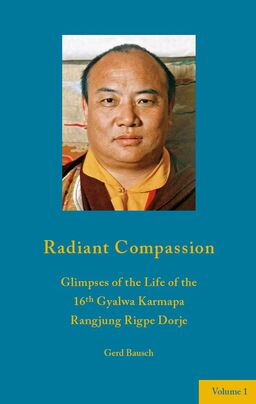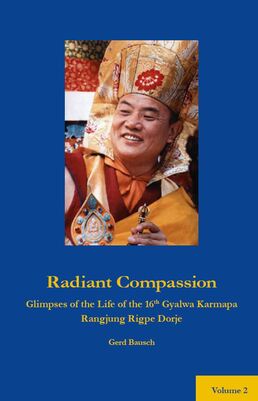|
Search this site:
|
Radiant Compassion.
Glimpses of the Life of the 16th Gyalwa Karmapa Rangjung Rigpe Dorje
(you can order it here)
The 16th Gyalwa Karmapa, Rangjung Rigpe Dorje (1924-1981), was one of the 20th century’s greatest spiritual masters and was highly venerated by teachers and disciples in all Buddhist traditions. Following the 1959 Chinese invasion of Tibet, as head of the Karma Kagyü tradition of Tibetan Buddhism, he went into exile in India. From his new home in Sikkim, as well as during his later extended voyages to the West, the Karmapa contributed immensely to the worldwide flourishing of the Buddha’s teachings like few other teachers. With his warmth of heart, his spiritual power and not least his openhearted humor, he moved people to their deepest core and overcame all cultural and social boundaries. Karmapa touched and inspired people from many different spiritual and religious traditions who were interested in inner development, including even those who feared or were critical of religion. His radiant compassion affected all who were fortunate enough to meet him.
Mainly based on accounts of the fortunate people who encountered this extraordinary master, in this book Gerd Bausch writes about the late 16th Karmapa who effortlessly pushed the boundaries of the human imagination and provided people with a new outlook. Literally day and night, this great Kagyu master tirelessly assisted everyone who asked for his advice and help, welcoming all with infinite generosity. In addition to accessing other contemporary sources, Bausch conducted more than one hundred interviews with students of Rangjung Rigpe Dorje, who relate their first-hand experiences.
Prefaces by HH Sakya Trizin, Dzongsar Khyentse Rinpoche and Beru Khyentse Rinpoche.
In addition to part 1 which follows chronologically his life, volume 1 of the book includes interviews with and accounts of His Holiness the Dalai Lama, His Holiness Sakya Trizin, Lama Gendün Rinpoche, Beru Khyentse Rinpoche, Dzigar Kongtrül Rinpoche, Jigme Rinpoche, Arnaud Desjardins, Jetsünma Tenzin Palmo, Lama Ole Nydahl, Lama Tsültrim Allione, Matthieu Ricard, Sharon Salzberg and others (see table of contents). Volume two includes the recollections of Lama Gendün Rinpoche, Nedo Kuchung Rinpoche, Zurmang Gharwang Rinpoche, Bardor Tulku Rinpoche, Karma Trinlay Rinpoche, Traleg Khandro, Hannah Nydahl, Lama Ole Nydahl, Achi Tsepal, Larry & Girija Brilliant, Erik Pema Kunsang, Steve Roth, Dr. Andrea Loseries-Leick and many others.
“This book provides a first-hand view into his exceptional qualities, as it describes his unceasing activities for the benefit of beings and his tireless endeavor to promote a close relationship between the different branches of Tibetan Buddhism.“
His Holiness the 41st Sakya Trizin
Volume One and Two of the book are published by Edition Karuna : www.edition-karuna.de
You can order it here.
For extracts of the book, please click here.
Thank you for your support in making Radiant Compassion possible.
Vol. 1: 384 pages & 8 color pages, hardcover.
You can order both volumes, please have a look here
His Holiness the 41st Sakya Trizin
Volume One and Two of the book are published by Edition Karuna : www.edition-karuna.de
You can order it here.
For extracts of the book, please click here.
Thank you for your support in making Radiant Compassion possible.
Vol. 1: 384 pages & 8 color pages, hardcover.
You can order both volumes, please have a look here
More about the book:
Although every picture or film I saw of the 16th Karmapa inspired me deeply, I did not initially intend or even dare to write a book about his life, but instead had planned to publish the life history told by his attendant Lama Tsültrim Namgyal, and to add to this account some interviews with more of Karmapa’s students.
In 2010, when I started working on this topic – almost thirty years after his death – no book had been written about him. I had already gathered so much interesting information with my interviews and other sources that when my first idea proved to be unrealistic, I decided to compile an account of this master’s life. Since the first time I saw his photo in a temple, he completely fascinated me, though I lacked the good fortune to meet him in his 16th incarnation.
But at the same time it becam clear, that in no way I was capable nor did I intent to write a classical hagiography, a namthar, but wanted to find out what it was, what made people change in his presence, and tried with the less interference of myself possible, to let them relate their -- subjective but nevertheless very moving -- experience.
In my efforts over the years to collect material and interview students of the 16th Gyalwa Karmapa, the community of practitioners (in Sanskrit called Sangha*) fortunately helped me a great deal: Assistance came from everywhere. Without the wholehearted support of those admirable people, this book would have remained only fragmentary.
The book is based on one hundred interviews in India, Nepal, France, Germany, Spain and the US, as well as by telephone. From great masters such as His Holiness Sakya Trizin Rinpoche, head of one of Tibetan Buddhism’s four major schools, to ‘simple’ practitioners, people shared stories of their encounters with the great master. Given the subjectivity of the interviews, they provide only a small and very personal impression of the 16th Karmapa. I nonetheless feel that this limited perspective in no way trivializes the Gyalwa Karmapa’s life and activity. Precisely because those who contributed their recollections share their subjective perceptions, we can form an impression of what the 16th Karmapa was able to awaken in people.
To some extent the book’s style reflects the Karmapa’s life: Like his traditional training and activity in Tibet, the first chapter of volume 1 is pretty much based on already existing biographies. In exile and in the West, the 16th Karmapa’s activity gradually developed in cultures that were new to him, but to which he responded like water that adapts to any environment. As his activity unfolds and becomes increasingly varied, the book’s structure also changes: More and more individuals who were lucky enough to have met Rigpe Dorje describe their experiences with him.
The first volume includes such information concerning the lifespan from his birth until the end of Karmapa’s first journey to the West. The second volume traces the rest of his life, his Parinirvāṇa and his cremation, and deepens some themes introduced briefly in the first part and the interviews. In the final section, the 16th Karmapa speaks himself, with a public interview and instructions about a practice.
Gerd Bausch


